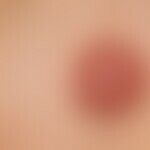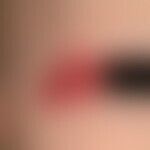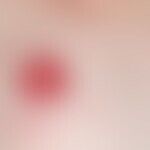Synonym(s)
DefinitionThis section has been translated automatically.
Most common, benign, usually isolated, rarely multiple, congenital or acquired in the first weeks of life (dysontogenetic) vascular tumor with capillary or mixed capillary-cavernous vascular proliferation (hemangioma) and a phasic course of proliferation, growth arrest, regression (duration of regression over years, not infrequently until puberty), and complete healing (restitutio ad integrum, very rarely defect healing).
ClassificationThis section has been translated automatically.
To be distinguished according to the floor of the vascular lesions are:
- Superficial intracutaneous hemangioma (60%)
- Mixed (intra-/subcutaneous) hemangioma (25%)
- Deep, subcutaneous hemangioma (15%).
Further distinctions according to particular growth behavior:
- NICH (Non-involuting congenital hemangioma).
- RICH (Rapidly involuting congenital hemangioma)
- Reticular, hemangioma of the infant
- NH ( Neonatal hemangiomatosis)
- Type I (Benign neonatal hemangiomatosis)
- Type II (Diffuse neonatal heman giomatosis)
- IH-MAG (Infantile hemangioma with minimal or arrested growth)- Special form with fine telangiectasias with absent or minimal proliferation.
Complicating hemangiomas limit organ function, tend to ulcerate, cause limitation of movement, cause aesthetic impairment. The following complications should be noted depending on the size or location:
periocular: amblyopia;
nasal: cyrano nasal, obstructrion;
auricular: obstruction, ulceration;
labial: drinking disorders;
intertriginous: ulceration;
segmental/face: PHACE syndrome (spinal dysraphia, anogenital malformations)
segmental/lumbosacral: PELVIS syndrome; hemangioma size >3-5% of KOF: heart failure,in 42% of cases liver hemangiomas (Metry DW et al 2004), hypothyroidism.
You might also be interested in
Occurrence/EpidemiologyThis section has been translated automatically.
Most common benign tumor of childhood, occurring in 1.1-2.6% of mature newborns. Girls are 1-5 times more frequently affected than boys. In premature babies the prevalence of hemangiomas correlates with the immaturity of the children:
- Prevalence at birth weight < 1,500 g = 15%
- Prevalence at birth weight < 1,000 g = 20-30%.
The prevalence in Asian and black African children is significantly lower than in Hispanic or Caucasian children.
EtiopathogenesisThis section has been translated automatically.
Complex, regulatory defect of angiogenesis in early pregnancy (6th-10th week of gestation) characterized by loss of angiogenesis-inhibiting signals (TIMP = tissue inhibitor of metalloproteinase) and by upregulation of angiogenesis-promoting growth factors, e.g. VEGF-2 (vascular endothelial growth factor) or apoptosis-inhibiting(IGF-2= insulin-like-growth-factor) factors.
Placental hypoxia also appears to play a role in the development of hemangiomas (see prevalence of hemangiomas in preterm infants and their association with retinopathy of prematurity). Hypoxia induces via signal proteins e.g. HIF-1alpha (= hypoxia-inducible factor-1alpha), GLUT-1 (glucose transporter) in endothelia, which increases their ability to take up glucose with the consequence of increased neovascularisation through VEGF-regulation.
Embolised cells from the placenta, as the hemangioma endothelia are immunohistochemically similar to the placenta.
Segmental hemangiomas represent an overlap between vascular tumors and malformations see also PHACE syndrome.
The rare cases of familial hemangiomas show somatic mutations of the 5q31-33 gene. Candidate genes in this area are growth factors like FGF-4 (fibroblast growth factor 4) and PDGF-beta (platelet derived growth factor-beta).
ManifestationThis section has been translated automatically.
LocalizationThis section has been translated automatically.
ClinicThis section has been translated automatically.
- Superficial (intracutaneous) focal haemangiomas: Formation of raised, deep red, strawberry or raspberry-like furrowed, completely painless tumours of rubbery to sponge-like consistency with a tendency to pronounced growth in the first weeks of life and occasional ulceration on the surface.
- Mixed (intra-/subcutaneous) haemangiomas: Progression as in superficial haemangiomas. Mostly deep red hemangiomas with a voluminous deep portion (iceberg phenomenon).
- Deep (subcutaneous) hemangiomas: protrusion of a frequently unchanged skin over a bulging elastic, blue-red shimmering node. Also occurs in combination with a superficial hemangioma. It is characterized by rapid growth during the neonatal period.
HistologyThis section has been translated automatically.
Lobular vascular pattern with partly solid and undifferentiated, partly differentiated, capillary vascular proliferates or also ectatic vascular spaces with mature cellular endothelial lining extending into cutis and subcutis. Moderate nuclear polymorphism; mitotic rate is often markedly increased (especially in the active growth phase of hemangiomas). In late stages, vascular convolutions largely regressed. Increasing fibrosis with transition to a loosely textured scar zone.
Immunohistology: Endothelia are positive for CD31 (von Willebrand factor), integrin and VEGF ( vascular endothelial growth factor). Immature endothelia are positive for Glut-1 antibody(glucose transporter). NICH and RICH - hemangiomas are GLUT-1 negative!
DiagnosisThis section has been translated automatically.
The diagnosis results from the clear clinical findings (visual diagnosis) and the anamnesis. Depending on the location and size, further diagnostics are required with regard to extension, course and possible complications:
- Size extension: measurement and photo documentation.
- Depth extension: sonography (if possible: 3-D reconstructed).
- Perfusion measurements: Doppler sonography.
- Hemangiomas > 10 cm in diameter: coagulation status (fibrinogen consumption), differential blood count (platelets).
- Hemangiomatosis (see below Hemangiomatosis, neonatal).
Three simple questions may be helpful in differentiating hemangioma from vascular malformation:
Present at birth?
- Yes: rather malformation or congenital hemangioma (RICH, NICH).
- No: rather hemangioma
Increased in size?
- Yes:rather hemangioma
- No: rather malformation
Become smaller?
- Yes: rather hemangioma, RICH
- No: rather malformation
Differential diagnosisThis section has been translated automatically.
Important: A new hemangioma occurring after the 6th week of life is not a classical infantile hemangioma!
- Granuloma pyogenicum: Frequent disease of infancy! Usually occurs after the 6th year of life. Typical are 1-3 cm large, rarely larger, solitary, soft, spherical, easily bleeding, red, blue or black, sharply demarcated papules (nodules). Rapid growth in the initial phase.
- Neonatal hemangiomatosis: Usually multiple hemangiomas of the skin with organ involvement. Clinical suspicion in case of multiple hemangiomas.
- Nevus flammeus (important DD, especially in reticular hemangioma of infants): Vascular malformation of different size, usually only appearing as discrete red spots in infancy and childhood, without symptoms (no hemangioma!). No spontaneous growth of thickness in the first months of life. Angiomatous transformation only in the course of life!
- Lymphangioma: Important DD in the deep lying hemangiomas is lymphangioma cavernosum. Clinical: Skin-colored, cushion-like, succulent, usually indistinctly circumscribed tumor of variable size. Elephantiasis, macrocheilia, macroglossia possible. If necessary, imaging procedures for clarification.
- Malformations, arteriovenous: Mostly localized on fingers and toes. Almost always hemifacial. Different sized tortuous, sometimes pulsating or whirring, protruding, blue-red vessels. Combination with other malformations is possible.
- Kaposi-form hemangioendothelioma (söten): In the cutaneous form, red or blue nodules and plaques may appear. In most cases, however, there are deeper tissue masses that can only be palpated or must first be detected by imaging examinations.
- Tufted hemangioma: Beginning with multiple, small, smooth-surfaced red, soft papules that slowly enlarge and persist at a certain size. Frequently accompanied by painfulness and hyperhidrosis (about 30% of cases). Spontaneous regression is extremely rare.
Complication(s)(associated diseasesThis section has been translated automatically.
Complications result from size and localization. The spontaneous risk of bleeding is greatly overestimated; bleeding only occurs in the context of ulcerations! The Kasabach-Merritt syndrome is observed in clinically and histologically definable caposiform hemangiodotheliomas. Important: Hemangiomas do not grow infiltratively! Typical complications depending on the localization:
- Periocular: Amblyopia, caused by partial occlusion of the visual axis.
- Nasal tip: Cyrano nose; regression is slower compared to differently localized hemangiomas.
- Intranasal: obstruction of nasal breathing
- Lips: Drinking obstacle
- Chin and anterior neck: Increased probability of hemangiomas in the upper airways
- Diaper region and other intertriginous areas: tendency to maceration and ulceration
- Lumbosacral region: Possible association with spinal dysraphism, urogenital or anal malformations (tethered cord syndrome)
- Large hemangiomas (> 3-5% of the body surface): heart failure (high-output), hypothyroidism (due to expression of a deodinase), thrombocytopenia
- Hemangiomatosis: Internal involvement.
TherapyThis section has been translated automatically.
Indications for therapy
Indications and methods of treatment are controversial in this benign, self-limiting and spontaneously regressing disease process. In the vast majority of uncomplicated, smaller infantile hemangiomas in non-critical localizations, "wait and watch" is the therapy of choice (about 80%). It should be noted that parents are under considerable pressure of suffering due to their own fears and unsolicited comments from relatives or passers-by. This often gives rise to an urgent parental desire for therapy.
Even in the age of the "beta receptor blocker propanolol", waiting is the therapy of choice for uncomplicated hemangiomas of the infant!
According to Höger, the main goals of treatment can be defined as follows:
- Prevention and, if necessary, therapy of life-threatening or functionally impairing complications.
- Prevention and if necessary therapy of painful ulcerated hemangiomas.
- Prevention and, if necessary, therapy of cosmetically impairing hemangioma residues.
- Indication for treatment depends on:
- Localization (periocular, nose).
- Growth behavior (rapid growth in the first months of life)
- Impending complications (size of the hemangioma > 10 cm in diameter, danger of ulceration; functionally disturbing localization, e.g. in the eye area with danger of shifting the direction of vision and consecutive strabismus or in the ENT area (danger of nasal or laryngeal impairment)
- Age of the child (growth phase of the hemangioma is still expected). After 1 year of age, the treatment option is missed.
Treatment methods:
- "Wait and see": For small, uncomplicated, only moderately fast growing, non-obstructive hemangiomas outside openly visible areas of skin, "active non-intervention" is the method of choice
- Propranolol systemically (according to Prof. Ruef, Children's Hospital Heilbronn), see also guidelines:
- Therapy of first choice, start as early as possible from the 2nd month of life onwards
- intake with meals because of the risk of hypoglycemia, inpatient initiation phase (bradycardia), dose 1.5-2 mg/kg bw / day (good efficacy, few NW)
- If necessary, short therapy break in case of bronchial infections, avoid beta-mimetics because of the risk of a rebound effect
- Duration of treatment approx. 6 months, longer if necessary in case of pronounced findings and/or rebound
- Propranolol topical (off-label) /en/dermatology/propranolol-gel-131803" title="Propranolol gel:
- no systemic levels, no systemic NW
- in previous studies no indication of developmental or growth impairment
- indicated for superficial and shallow ICH
- no contact of the gel to mucous membranes, no local therapy in the face!
- Cryosurgery: Indication for small, uncomplicated, superficial, intracutaneous hemangiomas localized on the face with rapid growth (cosmetic indication).
The success of cryosurgery is on average 75% regression within 4 weeks and is the better, the flatter the tumor and the earlier the hemangioma is treated. Use cryosurgery either as a contact procedure (loosely apply cryostempel, do not press on, stamp temperature -180 °C to -196 °C, contact duration 10 seconds) or as an open spray procedure (rarely used today). To protect the surrounding area from frostbite in the open spray procedure, prepare moulage with a silicone kneading compound (e.g. Silicone Kneading Compound, Orbis-Dental Frankfurt/M), alternatively cover the surrounding area with hard zinc paste. A 1-hour pretreatment with EMLA cream is recommended (Note: Apply ointment as thick as the back of a knife and cover with a bandage; pretreat the mucous membrane area with lidocaine cream or eye drops containing lidocaine). Spray the hemangioma with nitrogen (2 cycles) so that the surface is briefly frozen. Dry dressing. Rarely, a second cryosurgical cycle is necessary after 4-5 weeks.
Notice. Cryosurgery is not indicated after the 1st year of life.
- Laser therapy: Successes are described to the same extent as with cryosurgery by the use of lasers. Laser treatment as well as cryosurgery are to be considered as "kick-off treatment" for spontaneous healing. Comment: Laser therapy of hemangioma is considered obsolete. Experimental: Furthermore, good therapeutic results have been reported under early local treatment with a 5% imiquimod cream (3 times/week, for an average of 17 weeks) (method is not recommended!).
- Ulcerated hemangiomas:
- Analgesia (e.g., acetaminophen 30-40 mg/kg bw/day in 3-4 ED; alternatively, ibuprofen 20-30 mg/kg bw/day in 3-4 ED).
- Antisepsis: baths with solution containing chlorhexidine. After drying, apply ointment grid, possibly antibiotics e.g. fusidic acid).
- Antibiotics: In case of extensive superinfection systemic antibiosis according to antibiogram.
- Hemangiomas after regression:
- As residuals after spontaneous hemangioma regression, irregularities of the skin surface, vascular dilatation, scars after ulceration or skin sacs after very large hemangiomas are observed. In these cases, surgical correction may be considered.
- OBSOLET: systemic glucocorticoids, interferon, vincristine.
External therapyThis section has been translated automatically.
- Propanolol local: 0.5% Timolol gel: After the encouraging success with systemic beta-blockers, local beta-blockers have also been successfully applied to superficial hemangiomas (timolol maleate 0.5% in gel form, 2 x daily).
- Local propanolol: Experience in smaller groups has been made with a 1% magistral propanolol formulation (propanololol hydrochloride 1% in DAC base cream; application: 2 x daily under occlusion with a plaster bandage for 6-12 weeks).
Radiation therapyThis section has been translated automatically.
Internal therapyThis section has been translated automatically.
Propranolol (therapy of the 1st choice: various cases and smaller and larger studies are available, furthermore there is more experience with "off label use" over several years). Approval of Propranolol for this indication is available for"Hemangiol" drinking solution since 09. 2014): Start: 1.0 mg/kg KG p.o. in 3 ED distributed over the day. Therapy under monitor supervision; week 2: with stable circulation conditions 2.0 mg/kg bw in 3 sessions per day. From week 3: 3.0 mg/kg bw/day as continuous therapy over 2-4 months or until growth stops. Clinical results (fading of the hemangioma) occur already in the first days of therapy (Saint-Jean M et al. 2011).
A possible explanation for the good therapeutic efficacy of propanolol is the induced vasoconstriction and declining expression of VEGF and FGF (see below growth factors). It is recommended to perform this therapy in cooperation with a paediatrician (see day 1 above with monitoring, control of laboratory values including renal and FC values). I. A therapy duration of 6 months is sufficient.
Less common or meanwhile unusual procedures:
- Glucocorticoids (for large, complicated, fast-growing hemangiomas: infant hemangiomas in the facial region are particularly stressful cosmetically and must be considered as "complicated hemangiomas"): Oral interval therapy with glucocorticoids (e.g. prednisolone) 2-5 mg/kg bw for 14 days; if necessary, repeat the cycle once or twice if the hemangioma grows again after another 14-28 days. Today, glucocorticoids are considered obsolete, especially by pediatricians.
- Embolisation by direct puncture e.g. with isobutyl cyanoacrylate: This procedure is hardly ever performed anymore! High specialization required!
- Intralesional injections with bleomycin (this procedure is hardly ever considered anymore): 4-6 injections at intervals of 2 weeks (dosage: 1.0-2.0 ml/cm2). In case of signs of disseminated intravascular coagulation, immediate intensive pediatric measures: administration of anticoagulants(systemic heparins, systemic coumarins).
- Interferon alfa-2b (is rather disappointing; data are weak; hardly ever used): The standard dosage provides for an initial dose of 1 million IU/m2 KO/day subcutaneously (in the evening), which is slowly increased to 3 million IU/m2 KO/day. Period of application: 4 months. The effect of interferon is slow to set in. Combination with glucocorticoids is possible.
Operative therapieThis section has been translated automatically.
Progression/forecastThis section has been translated automatically.
Most hemangiomas undergo a stage-like development of latency, proliferation, plateau formation and regression. The growth phase lasts (typically) 9 months, but may be completed earlier.
- Latency phase (about 50% of hemangiomas are first observed at this stage): The hemangioma is a rather bright spot with one or more centrally located red papules, often combined with telangiectasia.
- Proliferation phase (beginning: 4-8 weeks post partum): Unpredictable, rapid growth of thickness and area until 10-11 months of life. In general, growth is faster in the first 5 months than in the months 6-10. Growing hemangiomas appear as warm, bulging, light to dark red plaques or nodules. Growth periods of up to 17 months are rarely observed.
- Plateau phase: A phase of no longer growth-active clinical constancy follows the proliferation phase. It lasts about 6-12 months.
- Regression phase: This phase follows on seamlessly from the plateau phase and lasts several years. Larger hemangiomas lose about 10% of their volume per year. After 5 years, 50% of the hemangiomas have spontaneously regressed, after 7 years 60% and after 9 years 90% of all hemangiomas. In the regression phase, the hemangiomas lose their bulging consistency. Grey or white spots appear on the surface, indicating normal skin.
- Residual findings: In general, 70% of superficial infant hemangiomas regress up to the age of 12 years without leaving residuals. In the remaining cases irregularities of the skin surface are observed (due to previous overstretching, scars after ulceration. Deeper-lying hemangiomas usually do not regress completely, leaving slack skin overstretching and deep nodular, fibromatous changes in the fatty tissue.
Note(s)This section has been translated automatically.
- Periocular hemangiomas: Can lead to astigmatism and myopia by direct compression of the eyelids. The consequence of the asymmetrical refractive error (anisometropia) is amblyopia. It can be induced by partial occlusion of the visual axis by the hemangioma or by a hemangioma-induced strabismus. Opthalmological control!
- Nasal hemangiomas: They appear bulging (expansion only possible outwards) and recede more slowly.
- Upper lip hemangiomas: Very slow and often only partial regression in relation to differently localized hemangiomas.
- Intertriginous hemangiomas (axillae, groins, neck wrinkles). Tendency to ulceration by maceration and secondary pyodermization.
- Haemangiomas > 10 cm: tendency to sudden central necrosis with extensive ulceration and possibly secondary pyodermization.
LiteratureThis section has been translated automatically.
- Bennett ML et al (2001) Oral corticosteroid use is effective for cutaneous hemangiomas: an evidence-based evaluation. Arch Dermatol 137: 1208-1213
- Chiller et al (2002) Hemangiomas of Infancy, Clinical Characteristics, Morphologic Subtypes, and their Relationship to Race, Ethnicity, Sex. Arch Dermatol 138: 1567-1576
- Djawari D (2006) Updates in the early treatment of infantile hemangiomas. Act Dermatol 32: 418-420
- Dinehart SM (2001) Hemangiomas: evaluation and treatment. Dermatol Surg 27: 475-485
- Ezekowitz RA et al (1994) Interferon alpha-2a therapy for life-threatening hemangiomas of infancy. N Engl J Med 330: 300
- Fließer M et al (2017) Acute complications of vascular anomalies in childhood. Dermatologist 68:790-795.
- Greig AV, Harris DL (2003) A study of perceptions of facial hemangiomas in professionals involved in child abuse surveillance. Pediatr Dermatol 20: 1-4.
- Ho N et al (2007) Topical imiquimod in the treatment of infantile hemangiomas: a retrospective study. J Am Acad Dermatol 56: 63-68.
- Höger PH (2012) Hemangiomas. Dermatologist 63: 112-120
- Höger PH (2006) Hemangiomas: therapy of choice is close observation. ÄP 2: 26-28
- Hohenleutner U et al (1996) The treatment of infantile hemangiomas with the flashlamp-pumped pulsed dye laser. Dermatologist 47: 183-188
- Léauté-Labrèze C et al (2008) Propranolol for severe hemangiomas of infancy. N Engl J Med 358: 2649-2651.
- Metry DW et al (2004) Association of solitary, segmental hemangiomas of the skin with visceral hemangiomatosis. Arch Dermatol 140:591-596.
- Omidvari S et al (2005) Role of intralesional bleomycin in the treatment of complicated hemangiomas; prospective clinical study. Dermatol Surg 31: 499-501
- Pope E et al (2011) Topical timolol gel for infantile hemangiomas: a pilote study. Arch Dermatol 146: 564-565
- Ruef P, Mangatter A. Therapy of infantile hemangiomas - update 2016; Phlebology 2016; 45: 194-200.
- Sadan N, Wolach B (1996) Treatment of hemangiomas of infancy with high dose of prednisone. J Pediatr 128: 141-146
- Saint-Jean M et al (2011) Propranolol for treatment of ulcerated infantile hemangiomas. J Am Acad Dermatol 64:827-832.
- Schneider M (2015) Local propanolol therapy complements treatment for hemangiomas. Hautnah 27: 146-150
- Weibel L (2009) Propanolol - a new therapy for infantile hemangiomas. Paediatrica 20: 27-29
- https://www.awmf.org/uploads/tx_szleitlinien/006-100l_S2k_Infantile-Haemangiome-Saeuglinge-Kleinkinder_2020-12.pdf
Incoming links (28)
Angiomatous nevus; Beta-receptor blockers; Blood sponge; Blood sponge; Cryosurgery; Encephalocraniocutaneous lipomatosis; Facial swelling; Glut-1; hamartoma of the skin; Hemangioma, capillary; ... Show allOutgoing links (30)
Angiogenesis; Apoptosis; Arteriovenous malformation; Beta-receptor blockers; Candidate gene; Chlorhexidine; Disseminated intravascular coagulation; Gene; Glut-1; Growth factors; ... Show allDisclaimer
Please ask your physician for a reliable diagnosis. This website is only meant as a reference.


















































